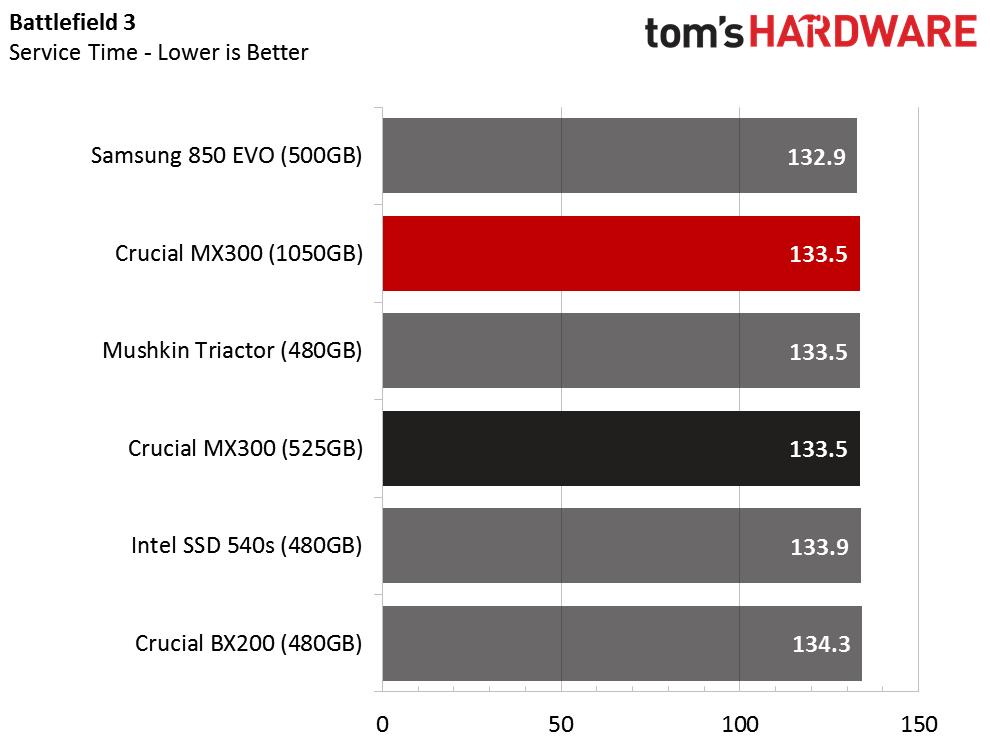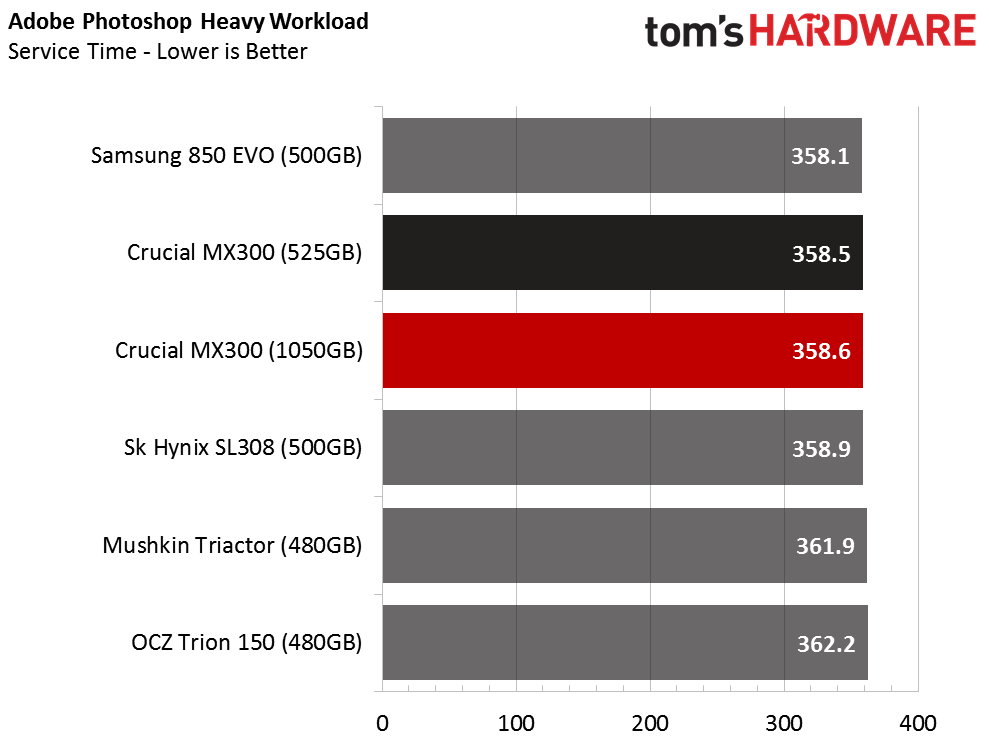Crucial MX300 525GB and 1050GB SSD Review
The Crucial MX300 has moved out of the limited edition cycle and is now a retail, mainstream product. Armed with Micron's new 3D TLC, the highest density flash available, the series could redefine the mainstream SSD market with a new low price point.
Why you can trust Tom's Hardware
Application Performance
PCMark 8 Real-World Software Performance
For details on our real-world software performance testing, please click here.










It's taken Crucial several years, but it looks like the MX300 is hot on the heels of the Samsung 850 EVO. The EVO's random read advantage keeps it at the top of the charts in many of the tests, but the MX300 is very close, and even matches the EVO, in several key applications.
Application Storage Bandwidth
In this chart, we average the results for each drive and present them as throughput. Both MX300 products move right behind the 850 EVO while outperforming the planar TLC-based products. Overall, 3D NAND dominates in real world applications.
PCMark 8 Advanced Workload Performance
To learn how we test advanced workload performance, please click here.



I expected a larger gap between the MX300 SSDs in these tests. The steady-state sequential test with mixed workloads showed more separation between SSDs, but during the PCMark 8 test, the two drives perform in lockstep most of the way. We focus mainly on the light workloads (the recovery phase) for consumer use. The heavy workload is only applicable to heavy-write environments.
Total Service Time



Again, we are only worried about the light workload portion of the test because consumer SSDs are built for general computing. In this test, the drives have a lot of data on the flash, so Crucial's Dynamic Write Acceleration allocation (the SLC cache) is fairly small. The service times are very low with the MX300, and it almost matches the Sk Hynix SL308 and Samsung 850 EVO.
Get Tom's Hardware's best news and in-depth reviews, straight to your inbox.
Disk Busy Time
Crucial SSDs with 16nm planar NAND, either in MLC or TLC form, suffered from high disk busy time. The Crucial BX200 is a good example of the issue. The first MX300 we tested also had a similar response before Crucial tuned the firmware. The new MX300 SSDs ship with an even newer firmware than what we tested the Limited Edition 750GB with. The MX300 series gets a little better with each update, and it will get even better as capacity increases.
Notebook Battery Life


The new Micron 3D NAND consumes less power (at the die level) than Micron's planar 2D NAND. In our notebook battery life test, where power actually matters, both MX300 SSDs perform very well. This series outperforms the Samsung 850 EVO 500GB and comes very close to leading the high-capacity class in on-battery time measurements.
MobileMark 2014 places a greater emphasis on system performance under battery power. The scale of the test has stretched, so we see more distinction between products. The notebook restricts the CPU, system memory and bus speeds when it is on battery power. Some SSDs respond to the reduced speeds and various power states differently. Technologies like DEVSLP can ease power consumption, but the deeper the sleep, the longer it takes to resume from a low-power state. The MX300 SSDs hit their marks and resume from sleep gracefully on Windows 10 (pre-anniversary update).

Chris Ramseyer was a senior contributing editor for Tom's Hardware. He tested and reviewed consumer storage.
-
hannibal Nice! Competition to 3d nand is just arriving! The Samsung did have monopoly too long time, now there is competition ones more.Reply -
alextheblue Drives like this don't appeal as much to the enthusiast directly, but they still benefit everyone. Performance is plenty good for most mainstream systems, and as cost per GB decreases they displace HDDs in more OEM systems. This is great because it makes it a lot easier to suggest an SSD model to budget-minded purchasers. We're still not quite where I want to be, but getting there. In the not-so-distant future I can envision building a system with a next-gen NV boot drive and 3D TLC storage drive(s), taking the place of my current SSD/HDD setup.Reply
Oh, and I'm really hoping the cable part of the PCIe 4.0 standard takes hold. I'd rather go that route than multiple M.2 drives. -
bit_user Thanks for the benchies, Chris. I wish the SSD Charts would still be getting updated! (hint, hint)Reply
BTW, I always liked the end-to-end data protection features in Crucial's MX series. To my knowledge, they and Intel's 500-series drives are the only ones to offer this in the consumer segment. Is that (still) correct?
-
CaedenV Man, I take my eyes of the SSD segment for a little bit and the whole landscape changed! I bought all of the SSDs in my house back when they were ~$1/GB. For what I paid for my 500GB of SSD storage I could be looking at 2TB next month. That is just crazy.Reply
I guess the real question in my mind is when I rebuild my rig in ~2 years will I go for a 500GB-1TB performance m.2? Or a larger 2TB SATA drive? Or, if things keep droping in price like this will I be able to afford both?
Or better yet, will these drop in price enough to start replacing HDDs in my NAS box? Hmm... decisions decisions. -
bit_user Reply
The next 2 years will make the previous 2 years look static, by comparison. Expect $/GB to drop much further, and significant performance improvements. nvDIMMs will be on the scene, too.18552184 said:Man, I take my eyes of the SSD segment for a little bit and the whole landscape changed!
...
I guess the real question in my mind is when I rebuild my rig in ~2 years will I ...
BTW, M.2 doesn't necessarily connote NVMe. Although, by the time you upgrade, it'll probably be the norm. -
10tacle I have the 500GB EVO 850 and am happy with it, but if I were looking for a new SSD, the 1050 would be on my short list for a 1TB drive. Absolute raw performance numbers are not be as important to me as having that extra 50GB which is an entire Steam game install these days.Reply -
c0rr0sive I can't wait for the day that I can replace all my 4TB and 8TB disks with some solid storage, right now I can either go with enterprise grade disks for $7800, or go the SSD route for about $9800. Soon, hopefully soon it will be cheaper to go SSD for my needs.Reply -
CRamseyer The MX300 2TB is coming out of testing tomorrow morning. It will be interesting to see it compares to other products shipping today.Reply
As always, thanks for reading and the comments.


